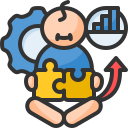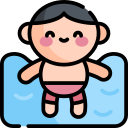
Conditions like cerebral palsy or other physical disabilities that affect movement and motor skills.

Growth-related pain, joint pain, and other issues affecting musculoskeletal health.

Challenges in achieving milestones such as crawling, sitting, and walking.

Difficulty in coordinating movements and maintaining balance, impacting daily activities and play.

Therapists use specific exercises aimed at improving each child’s motor skills, coordination, and balance.

Based on the child’s assessment, a combination of therapies may be recommended, including Occupational Therapy, Speech Therapy, Aquatic Therapy, and Physiotherapy.

By making sessions enjoyable, therapists help motivate children, encouraging them to participate and gain the most from each session.

Therapists work with parents, suggesting exercises and activities that can be done at home to reinforce the therapy.

Progress in gross motor skills such as crawling, sitting, and walking.

Greater control over movement and stability.

Relief from growth-related or joint pain through therapeutic exercises.

Enjoyable sessions that foster a positive attitude towards therapy.